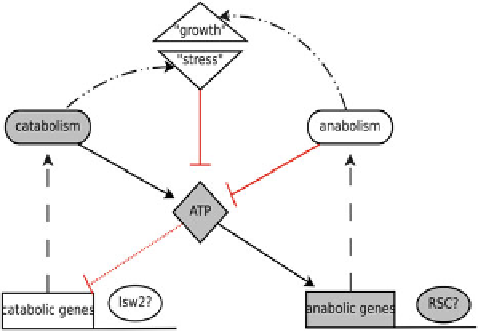Biology Reference
In-Depth Information
Fig. 12.5 The proposed dual negative feedback of energetics on gene expression via chromatin
remodelling. During the oxidative phase (
grey
) catabolism increases ATP synthesis rate leading to
a high ATP:ADP ratio thereby activating the transcription of anabolic genes. This leads to a
“growth-like” transcriptional response. This is potentially mediated by ATP-dependent nucleo-
some remodelling (
RSC
), which simultaneously represses the transcription of catabolic genes.
When respiratory activity switches (resulting in the onset of the reductive phase), the protein
products of the anabolic genes, e.g. amino acid and protein synthesis enzymes, lower the ATP:
ADP ratio. This results in a reconfiguration of the promoter structure where the production of
anabolic transcripts decreases and the catabolic transcripts increase, i.e. typically that of a “stress-
like” response. Supporting this concept, the initial response of many cellular stresses is a decrease
in the ATP:ADP ratio caused by disruption of protein, membrane and organelle function
oestrogen systems, where pulses of stimulant or ATP caused a damped ultradian
oscillation in nucleosome structure (M´tivier et al.
2003
; Nagaich et al.
2004
).
12.7 Organelle Remodelling: Mitochondrial Changes
During the Respiratory Cycle
Our data indicates that the reaction network is separated into catabolic and anabolic
processes. However, it is currently unclear how biophysical structure and physical
compartmentalisation integrate into this “programme”. The spatio-temporal hetero-
geneity of cellular structure greatly influences every aspect of the reaction kinetics
of the whole cellular network (Hiroi and Funahashi
2006
). The reactome therefore
has an intricate relationship with the organisation of DNA, RNA, protein, mem-
brane and organelle structure both in space and time. The metabolites and
transcripts involved in the core amphibolic carbon metabolism (glycolysis, gluco-
neogenesis and the tricarboxylic cycle) include some of the major oscillatory
components of the cell. In a respiring system the mitochondria and the integrity
of its structure are main determinants of the relative rates of the amphibolic
pathways of carbon metabolism. Additionally, the dual negative feedback loop on

Search WWH ::

Custom Search